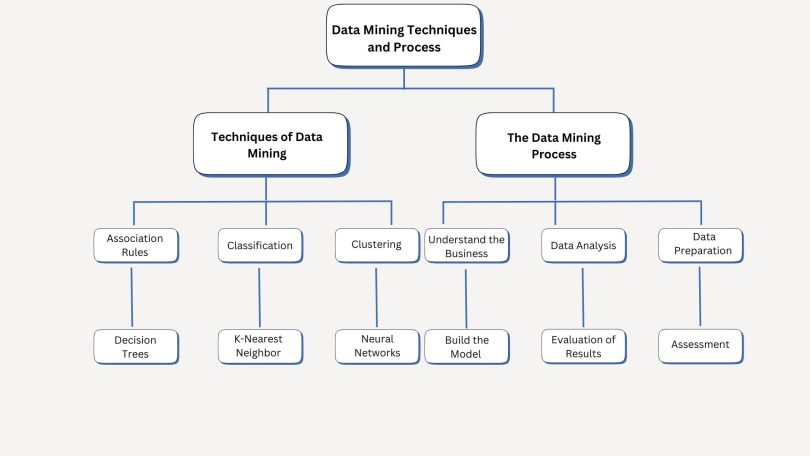Data Mining?
It is the extraction of information from large raw data sets information through the use of computers.
Techniques of Data Mining
It uses several processes and models whereby large data sets are analyzed and converted into information. Some of the commonly used techniques/methods are “classification”, “clustering”, “decision trees”, “K-Nearest Neighbor”, “association rules” “neural networks” and “predictive modeling”.
Association Rules
Market basket analysis is another name for this technique as it defines connections between variables in a dataset while possessing the value of linking separate pieces of information.
For example, it may examine the sales trends of a particular firm to identify which products are usually bought in combination; helps stores to organize, advertise and predict more efficiently.
Classification
This technique involves categorizing objects into predetermined classes and stating the features or similarities of the objects. It enables data to be well arranged and summarized depending on the features or product type.
Clustering
Similar to classification, clustering is a method that aims to group objects based on their similarities but at the same time, there are differences between them. For instance, classification will give you categories such as “shampoo,” “conditioner,” “soap,” and “toothpaste” while clustering may provide more generalized categories such as “hair care products” and “oral hygiene products”.
Decision Trees
While used in classification or prediction, decision trees are built upon a specific list of criteria or decisions. They filter data by asking a sequence of questions hierarchically and sometimes in the form of a tree that offers particular guidance and input from the users.
K-Nearest Neighbor
This algorithm categorizes data with the belief that similar data is grouped in close vicinity of one another. This is a non-parametric, supervised learning method used to predict group characteristics from individual information.
Neural Networks
These are processed through interconnected nodes which are made up of inputs, weights and outputs like the brain. Concerning the nodes, supervised learning transmits data through them and precise thresholds can decide the accuracy of a model.
Predictive Analysis
It utilizes past data to develop graphical or mathematical models for predicting future outcomes. This technique is similar to regression analysis and is used for predicting other unknown future numbers from the current information
.
The Data Mining Process
For efficiency’s sake, data analysts usually go through a series of steps when performing data mining. Such an approach is useful in avoiding problems that may occur in the absence of adequate preparation.
Step 1: Understand the Business
It is important to understand the nature of the entity and the objectives of the project before touching raw data. Also understands the objectives that the company aims to achieve through data mining. The first step is to grasp the business environment and outline the goals of success.
Step 2: Data Analysis
Depending on the nature of the business problem, the attention is turned to the data sources, protection, management, acquisition, and the goal of the analysis. This step also includes the identification of the drawbacks of the data and how they may affect the mining process.
Step 3: Data Preparation
Involves data cleaning, data transformation and feature engineering.
Information is collected, transmitted, collected again, preprocessed, formatted, and verified for error and outlying values. At this stage, the size of the data is also taken into account since large data volumes hinder computations and analysis.
Step 4: Build the Model
Every step that has been described up to this point is a significant factor in model building or the construction of a model. With clean data, analysts use many data mining methods to discover relationships, trends and patterns in it. The data may also be employed in the development of prognosis models in that the results may be estimated from prior information.
Step 5: Evaluation of Results
The evaluation of the results is conducted to assess the effectiveness and efficiency of the entire system. This process involves analyzing the data mining outcomes to determine if they meet the desired objectives and provide valuable insights.
Step 6: Assessment
The last aspect of the data analysis phase is the assessment of the model’s results. It is then analyzed, summarized and reported to other decision makers who have no interaction with the data mining process.
Final Discussion and Tips
Data mining is the foundation of the process of transforming information into useful knowledge. When these techniques and processes are understood, and applied, companies are then able to identify these patterns and improve the way their businesses, as well as base their decisions on facts that enhance the business. However it is important to state that data mining is not a single solution; rather, it is an element that is a part of a wider context of business strategies. Therefore, businesses should promote data quality, talent and ethics for better chances of success.



Leave a Comment